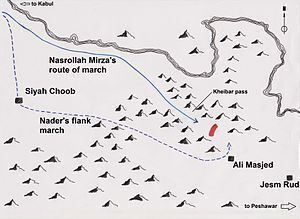10,000 engaged in battle
Total22,000
10,000 (engaged) under Nader Shah
12,000 (un-engaged) under Nasrollah Mirza 20,000 Result Decisive Persian victory | Date 26 November 1738 Location Khyber Pass, Pakistan | |
 | ||
negligible entire force either killed or captured or routed Similar Sabzevar expedition, Battle of Khwar Pass, Liberation of Isfahan, Herat Campaign of 1731, Western Persia campaign | ||
The battle of Khyber Pass (or Kheibar Pass) was an engagement fought in the mid-eighteenth century between the Persian empire of Nader Shah and the Mughal vassal state of Peshawar. The result was an overwhelming victory for the Persians opening up the path ahead to invade the crown-lands of the Mughal empire of Muhammad Shah.
Contents
The context
The first major military event of Nader's new reign as Shah of Persia was the conquest of Qandahar. Already Nader was in the process of concocting a pretext for an invasion of Mughal India. Succeeding in capturing Qandahar and putting an end to Hotaki Afghan rule, he seized on the excuse that the Mughal authorities had been deliberately non-cooperative in handing over spies and fugitives from the Afghan army.
Reza Qoli, Nader's son, was appointed as viceroy and sent to Khorasan freeing Nader to move east a day after towards Jalal Abad where he made an encampment. At this point in time intelligence reports came in that the governor of Kabul & Peshawar had raised an army of some 20,000 (mostly Afghan warriors) and despite receiving no aid from Delhi was intent on resisting Nader's incursion upon his lands.
The battle
The position that had been chosen to resist the Persian army could scarcely have been better selected, as through the narrow pass of Kheibar only a small column of men could hope to march and any deployment into fighting formations would be an impossibility. Nader being convinced of the futility of a head-on struggle, instead opted for a more refined approach. A local guide informed him of a difficult yet traversable pass running parallel to that of Kheibar called the pass of Chatchoobi.
Setting out on November 26 from near Jalal Abad the Persian army arrived at Barikab (33 kilometres from the Kheibar pass) where Nader divided his army leaving Morteza Mirza behind with the bulk of the forces at his disposal and sending forth 12,000 men to the Kheibar pass under Nasrollah Qoli whilst he gathered a 10,000 light cavalry under his direct command. Beginning an epic flank-march of over 80 kilometres through some of the most unnavigable terrain in Asia Nader reached close to Ali-Masjed whence the 10,000 curved their route of march northwards and onto the eastern end of the Kheibar pass.
The Persian cavalry formed ranks and swept into a deadly charge against the startled forces who despite being twice their number, and resisting the initial shock of finding the Persians behind their positions, managed to somehow put up a valiant last stand before they were all either killed, taken prisoner or fled the field of battle leaving the governor of Peshawar to be made captive. The Russian general Kishmishev wrote of the campaign as a "masterpiece" of warfare.
The consequences
Soon after, both Peshawar and Kabul fell to Persian subjugation and Nader marched against Lahore. The army which the governor of Lahore had arrayed against the onslaught of the invaders was routed when Nader pounced upon it from an unexpected direction forcing the remainder to withdraw to the city walls and shortly afterwards surrender as well as pay a heavy tribute in gold.
The news of these catastrophes engulfed the authorities in Delhi in horror as they sent frantic requests of troops and levies throughout northern India.
